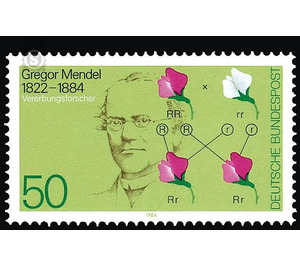100th anniversary of death from Gregor Johann Mendel - Germany / Federal Republic of Germany 1984 - 50 Pfennig
Theme: Calender
| Country | Germany / Federal Republic of Germany |
| Issue Date | 1984 |
| Face Value | 50.00 |
| Color | green |
| Perforation | K 14 |
| Printing Type | 5-color offset |
| Stamp Type | Postage stamp |
| Item Type | Stamp |
| Chronological Issue Number | 1072 |
| Chronological Chapter | GER-BRD |
| SID | 134874 |
| In 39 Wishlists | |
Johann Mendel was born on July 22, 1822 in Heinzendorf (northern Moravia, today Czechoslovakia) as the son of a farmer. His parents allowed him to attend high school, but the funds were not enough for a university degree. In 1843 he entered the Augustinian monastery in Brno and received the religious name Gregory. Four years later he received the Catholic ordination and was sent to the University of Vienna from 1851 to 1853 at the expense of the monastery. He studied descriptive science, physics and mathematics and taught after his return these subjects at the State Realschule in Brno. In 1854 Mendel began in the garden of the Augustinian monastery, where he later served as abbot, with his well-thought-out and targeted crossbreeding experiments on pea and bean breeds. In doing so, he made the important discoveries that bastards born of two races do not continue to breed constantly, but that in the generation of grandchildren the characteristics of the parent races emerge again, and in exactly predictable numerical ratios. He also noted from these in many respects happily selected experimental plants that the characteristics in question in the second generation occur completely independently of each other. The features he selected were mainly the color (yellow or green) and the shape (spherical-smooth or wrinkled-edged) of the mature pea seeds, which appeared constant in the initial races. Through astute reflection, Mendel also found the key to the theoretical understanding of these laws by postulating that each bastard forms different germ cells. His investigations and results Mendel published in a small, barely known series of publications of the Naturalist Association in Brno. His later breeding with hawkweed, because of the complexity of their reproduction, as we now know, produced quite different results than those with peas. Mendel's colleagues therefore took a wait-and-see approach to his discoveries. The manifold office tasks in the management of the monastery, not least the exhausting fighting because of the excessive taxation of his order, Mendel later no longer allowed the continuation of his breeding experiments. Finally, his results were completely forgotten. On January 6, 1884 Gregor Johann Mendel died in Brno from the consequences of a kidney infection. It was not until the turn of the century that three botanists (Correns, de Vries, von Tschermak) discovered Mendel's discoveries independently in their own crossbreeding experiments, which in his honor were called Mendelian rules. In 1902 the validity of the Mendelian rules was proved by Cuénot and Bateson also for animals. Even though Mendel had already dealt with several questions of heredity and proposed solutions, it was Mendel's merit that he first pointed out the independence of the individual features and the numerical calculation of their possible combinations. Thus, Mendel's discoveries continue to form the basis of all animal and plant breeding as well as evolutionary and mutational research. On the stamp the first of the Mendelian rules, the law of uniformity, is represented: If two races of one kind, which differ in only one characteristic, are crossed with each other, then all individuals of the first generation are equal to each other. In the illustrated example of a dominant inheritance suppresses the inheritance for red flower color (R) the additional inheritance for white flower color (r), whereby all offspring from this cross obtain a uniform flower color, namely red. (Text: Dr. Pedro Gerstberger, Department of Plant Ecology and Systematics of the University of Bayreuth)


